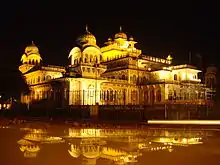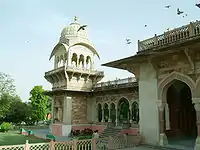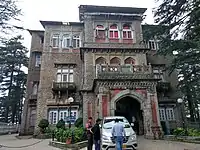Samuel Swinton Jacob
Sir Samuel Swinton Jacob, KCIE, CVO (14 January 1841 – 4 December 1917) was a British Army officer and colonial engineer, architect and writer, best known for the numerous Indian public buildings he designed in the Indo-Saracenic style.
Sir Samuel Swinton Jacob KCIE, CVO | |
|---|---|
 | |
| Born | 14 January 1841 |
| Died | 4 December 1917 (aged 76) |
| Resting place | Brookwood Cemetery |
Early life and education

Jacob was born in 1841 to Colonel William Jacob[1] (of the Bombay Artillery and a member of a distinguished military family) and Jane Swinton, granddaughter of Captain Samuel Swinton RN, who was the inspiration for the story of The Scarlet Pimpernel. He was educated at Cheam School and then at the East India Company Military College at Addiscombe where he was one of the last batch of graduates (graduating as an engineer in 1858).[2]
Career
Jacob was commissioned into the Bombay Artillery in 1858, qualifying five years later as a surveyor and engineer. After initial service with the Bombay Staff Corps in the Public Works Department, and a brief spell with the Aden Field Force in 1865–6, he was appointed in 1867 as chief engineer of the state of Jaipur in Rajasthan, India.[3] He was to spend the remainder of his working life in this position until he retired at the age of 71.[1]
At the time he became chief engineer and took charge of the public works department of the Jaipur it had only been in existence for seven years, having been founded in 1860.

He was promoted to lieutenant-colonel on 6 February 1885,[4] and to Colonel on 26 February 1889.[5] During the summer of 1902, he accompanied the Maharaja of Jaipur as a political officer during a visit to the United Kingdom to attend the Coronation of King Edward VII and Queen Alexandra. The coronation was originally scheduled for late June, but was postponed until 16 August 1902 when the King fell ill, prolonging their stay in London.[6]
Later career
Among his honours were the Kaisar-i-Hind Gold Medal for Public Service on 9 November 1901.[7][8] In the 1902 Coronation Honours list published on 26 June 1902 (the original date for the subsequently postponed coronation of King Edward VII), Jacob was made a Knight Commander of the Indian Empire (KCIE).[9][10]
He had no sooner retired to England in 1911 then he was recruited by the secretary of state for India to assist Edwin Lutyens and Herbert Baker in the design of New Delhi. Failing health soon forced him to withdraw from the assignment.[1]
He died at Weybridge on 4 December 1917[1] and was buried in Brookwood Cemetery in Surrey.
Personal life
He was married to Mary Brown (daughter of Robert Brown of Edinburgh) from 1874 until his death.[1]
Style

Jacob's department was responsible for the construction of everything in the state of Jaipur ranging from walls, outhouses, guard houses, roads, canals to major public buildings.
Compared with many British officials in India he was noted for his respect for local building traditions and skills, which led to his incorporating many Indian architectural features into his building designs. As a result, he became – with F. S. Growse, Robert Fellowes Chisholm, Charles Mant, Henry Irwin, William Emerson, George Wittet and Frederick Stevens – a pioneer of the Indo-Saracenic style of architecture.
For the benefit of other contemporary architects, Jacob published from 1890–1913 the Jeypore portfolio of architectural details, containing numerous drawings, in 12 volumes.[11]
Notable buildings
- Albert Hall Museum, Jaipur. Also called the Government Central Museum. Located on Ram Niwas Bagh, it was built between 1880 and 1887 after abandoning the original design by Frederick de Fabeck for which the then Prince of Wales had laid the foundation stone in 1876. Maharaja Ram Singh initially wanted this building to be a town hall, but his successor, Sawai Madho Singh, decided it should be a museum for the art of Jaipur.
- Jaipur Gate, 1886 (with Thomas Holbein Hendley). The "exotic" structure of Indian teak was carved in Shekhawati and transported to London for an exhibition. In 1926 it was moved to Hove, East Sussex, where it still stands outside Hove Museum and Art Gallery.[12]
- Jubilee Buildings, Jodhpur, 1887–96.[13]
- The Delhi State Election Commission's Office on Lothian Road near Kashmiri Gate in Delhi. Built 1890 to 1891, two-storey building housed the St. Stephen's College, Delhi from 1891 till 1941, when it shifted to its present campus.[14][15]
- Bikaner House, Mount Abu. Built 1893 as a summer residence for the Maharaja of Bikaner. It has now been converted into the Palace Hotel.
- Laxmi Niwas Palace, Bikaner. Built 1896–1902 and then extended from 1902 until 1926 into the Lalgarh Palace.
- Umed Bhawan Palace, Kota. Built in 1904. Now houses a WelcomHeritage hotel.[16]
- King George Medical College, Lucknow. Built 1905. Now called the King George Medical University.
- Peshawar Museum, Peshawar. Built 1907 as Victoria Memorial Hall.
- Rambagh Palace, designed by Jacob in 1905, built 1909–16 by Chiman Lal and Bhola Nath.[17]
- Daly College, Indore, 1912.
Gallery
 Albert Hall Museum, Jaipur
Albert Hall Museum, Jaipur Laxmi Niwas Palace, Bikaner
Laxmi Niwas Palace, Bikaner Lalgarh Palace, Bikaner
Lalgarh Palace, Bikaner Daly College, Indore
Daly College, Indore Umaid Bhawan Palace, jodhpur, Rajasthan
Umaid Bhawan Palace, jodhpur, Rajasthan.JPG.webp) Jaipur Gate, Hove
Jaipur Gate, Hove Gorton Castle, Shimla
Gorton Castle, Shimla
Notes
- The Times, 7 December 1917, Issue 41655. Obituary.
- The Times, 11 December 1858, Issue 23174.
- Colonel F. W. M. Spring, 'Bombay Artillery: List of Officers' (1902), entry 500.
- London Gazette, 10 February 1885.
- London Gazette, 26 February 1889.
- "Court Circular". The Times (36845). London. 13 August 1902. p. 8.
- "No. 27374". The London Gazette (Supplement). 9 November 1901. p. 7288.
- The Times, 9 November 1901, Issue 36608.
- "The Coronation Honours". The Times (36804). London. 26 June 1902. p. 5.
- "No. 27448". The London Gazette (Supplement). 26 July 1902. pp. 4189–4197.
- Thomas R. Metcalfe, A Tradition Created: Indo-Saracenic Architecture under the Raj, in: History Today, Volume 32, Issue 9, 1982.
- Antram, Nicholas; Morrice, Richard (2008). Brighton and Hove. Pevsner Architectural Guides. London: Yale University Press. p. 197. ISBN 978-0-300-12661-7.
- Vibuti Sachdev & Giles Tillotson, "Building-Jaipur-the-Making-of-an-Indian-City" p. 118 s.]
- "College to poll office, a 123-year-old quiet journey". Hindustan Times. 12 May 2013. Archived from the original on 31 October 2013. Retrieved 23 September 2013.
- "Archived copy". Archived from the original on 25 March 2008. Retrieved 26 July 2013.CS1 maint: archived copy as title (link). Retrieved 17 April 2008
- WelcomHeritage Umed Bhawan Palace
- Sachdev/Tillotson, "Building Jaipur the Making of an Indian City" p. 126 s.
Further reading
- Mitchell, Shelby, Nanji, Ameeta (2007). India Sublime – Princely Palace Hotels of Rajasthan (hardback). New York: Rizzoli. ISBN 978-0-8478-2979-8.CS1 maint: multiple names: authors list (link)